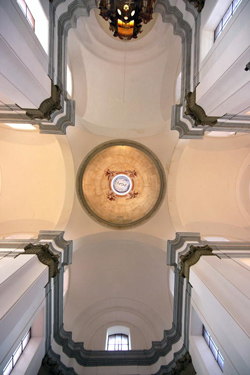
Mariánská Týnice will showcase Santini's buildings, models, and visualizations
 |
| photo: santini.cz |
"This region is characterized by the fact that there are ten buildings that were constructed according to Santini's design or under his influence. These are the so-called ten stars, and that's exactly what we want to present," she said.
According to her, a person visiting Santini's monuments in the region has no chance to see them all together. "We would like to present to them using models the shape and conceptual connections between the individual buildings. There will not only be models on display, but also visualizations of the architectural processes. It will thus be clear how the construction came to be, what spirit it has, what technical parameters it has, and it breathes a bit of sacred geometry," said Bukačová.
Santini's buildings in the Plzeň region were created in the first half of the 18th century in connection with the activities of Evžen Tyttl, the abbot of the Cistercian monastery in Plasy, who was a great patron and client of Santini. The first unique chapel in the region was the one in Mladotice, built in the shape of a star. This was followed by Marian Týnice and the monastery in Plasy.
The new exhibition, which is set to open next year, will complement the museum's current offerings. The entire first floor, covering an area of about 1000 m², is dedicated to the historical development of the region, inviting visitors to explore the past, with original objects placed in the environment of a small town, countryside, old school, and old church.
The museum is requesting funds under the project of the Plzeň Region, which is associated with the project of Plzeň as the European Capital of Culture for 2015.
The English translation is powered by AI tool. Switch to Czech to view the original text source.
0 comments
add comment
Related articles
0
27.06.2023 | J. B. Santini Aichel - Geometry of Sacred Space
0
13.09.2021 | The Plzeň Region completed the Baroque ambits of the pilgrimage site of Mariánská Týnice
0
20.06.2021 | Baroque day in Mariánská Týnice today presented the newly built ambulatory and chapel
7
02.02.2021 | The Pilsen Region has completed the construction of the Baroque ambulatory in Mariánské Týnice for 60 million
0
26.03.2017 | In Mariánská Týnice, the ambitus will be completed according to the original plans
0
20.12.2016 | The Baroque complex of Mariánská Týnice will finally be completed according to Santini after three centuries
0
05.06.2016 | The Marian monument in Týnice wants to complete the cloister according to Santini's vision






